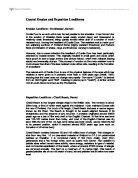However, due to wave refraction the headland of Durdle Door has been particularly attacked by coastal erosion. This originally resulted in small geo’s and caves which have grown in size to large arches (see picture below), which then collapse leaving stacks and eventually stumps. This process of erosion on the more resistant rock is much slower than that of the less resistant rocks either side, resulting in the formation of a headland.
The natural arch of Durdle Door is one of the physical features of the area which has retained a name given to it probably more than a 1000 years ago (Arkell, 1947), showing that the coast does not change very rapidly. The name " Durdle " is derived from an Old English word "thirl", meaning to pierce (as in "nostril"). A similar arched rock in south Devon is known as the Thurlestone.
Deposition Landform : Chesil Beach, Dorset
Chesil Beach is the longest shingle ridge in the British Isles. The tombolo is about 30km long, a third of which rests against the mainland. It join mainland Dorset with the Isle of Portland. For much of its length, Chesil Beach encloses a narrow lagoon known as the Fleet. The Beach is thought to be swash-aligned because of its straightness and the absence of any recurves. It probably originated around 20000 years ago as a bar of flint and chert in the English Channel. At that time sea level was 100-120 metres lower than today, and most of the English Channel was dry land. With the end of the Ice Age came rising sea-level; slowly, waves rolled the bar to its present position, which it reached around 6000 years ago (see work on formation of off-shore bars).
Chesil Beach contains between 50 and 100 million tons of shingle. This changes in size from very fine, 1-2 cm pea-sized material at Bridport to 5-7.5 cm potato-sized pebbles at Chesilton. It is comprised mainly of flint (from chalk), chert (from greensand) and a few foreign rocks, such as quartz from Devon. The variation in pebble sizes reflect recent wave activity, wave energy, variations in type of material, and commercial exploitation of the beach, where at present 27000 tonnes of shingle are removed annually. The berm is a maximum of 13 metres high. This beach of graded pebbles sits on an old beach of sand, silt and pebbles that is below low water level.
Some suggest Chesil Beach may form its own sediment cell, as there is little evidence present that shows new material entering its system.







